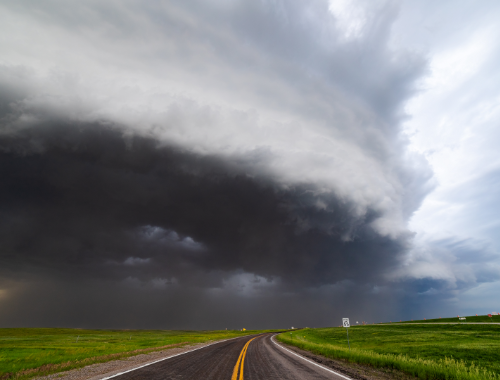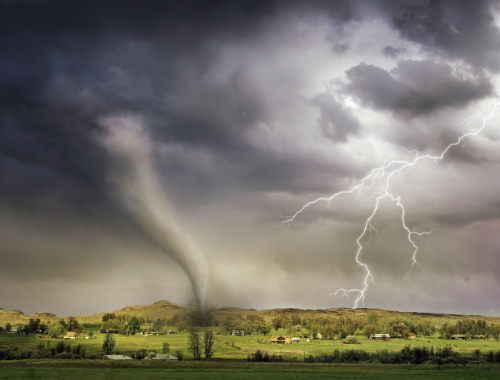Difference Between Derecho and Tornado
The term derecho has been thrown around quite a lot these days. Most of you must be hearing this term probably for the first time, or not. Derechos may not be as well known as tornadoes or hurricanes, but these can be just as powerful and destructive. So, by now you would have connected the dots in relation to derechos. You guessed it right! Derechos are powerful wind storms similar to tornadoes or hurricanes. But they are not the same.

What is a Derecho?
Derecho is pronounced similar to “deh-REY-cho” in English and means “straight ahead” in Spanish. It’s a widespread wind storm that produces walls of strong wind covering over 240 miles which is huge. Similar to a tornado, it is a fast-moving band of thunderstorms with destructive winds at 58 miles per hour or greater and in the occasional wind gusts upwards of 78 miles per hour, which is more than a hurricane. So, derechos are a large-scale thunderstorm event that is capable of causing a lot of damage much more than a tornado would cause. These are among weather’s most destructive phenomena associated with walls of rapidly moving showers or thunderstorms.

What is a Tornado?
A tornado is a narrow but very powerful rotating column of air that extends from a thunderstorm to the surface of the earth. Weather can be very extreme at times creating thunderstorms, cyclones, hurricanes, etc. Tornadoes are one of the most extreme and brutal forms of weather that form a small but violent funnel-shaped column of rotating winds. Also known as twisters, tornadoes reach from a storm cloud to the ground and when they are formed, they are a brutal force to reckon with. They grow larger and larger, hurling and twisting, and badly reaching down from the sky. So, tornadoes are violent spinning columns of air that extend from the ground to the clouds.
Difference between Derecho and Tornado
Wind Pattern
– Both derechos and tornadoes are extremely powerful weather events that carry wind storms brutal enough to cause destruction, but they have different wind patterns. A derecho is a fast-moving band of thunderstorms with destructive winds, but the winds are straight. Tornadoes, on the other hand, are violent spinning columns of air that extend from the ground to the clouds. So, a tornado is followed by rotating winds unlike derechos, which are a system of severe thunderstorms with straight-line winds.
Severity
– Tornadoes are swirling funnel of air coming down from the sky. The column of air falls down to the ground and the wind speeds can reach anywhere from 100 to a whopping 300 miles per hour. Anything that gets in the way of a tornado will be hurled upwards. Derechos are a system of severe thunderstorms that travel more or less in a straight line, but at a wind speed around 58 miles per hour or less, and sometimes very strong, from 75 to 100 miles per hour.
Cause
– Tornadoes are among the most violent storms that usually form in thunderstorms, but the really powerful ones that are called supercells which can bring lightning, strong winds, and flash floods. These conditions can cause spinning air currents within the cloud. In supercells, this rising air mass is very strong. As the air climbs, it changes direction and starts to move quickly developing into a huge cloud base which feeds the tornado. Derechos are a line of fast moving storms that form from a cluster of thunderstorms when weather conditions support the repeated production of downbursts within the same general area.
Derecho vs. Tornado: Comparison Chart

Summary
Both are powerful weather phenomena that have something to do with strong violent winds. Tornadoes are powerful columns of air falling down to the ground from the sky, but despite its violent nature, it is a local weather event and short-lived, compared to tropical cyclones that can stretch up to 1,000 miles and last for days. Derechos are quite similar to tornadoes but followed by straight-line winds caused y air being dragged down by precipitation. But, derechos are large-scale thunderstorm events that are capable of causing a lot of damage much more than a tornado would cause
What is one similarity between a derecho and a tornado?
Both are associated with bands of rapidly moving showers or thunderstorms and can be equally destructive and powerful.
Is a derecho stronger than a hurricane?
A derecho can pack lethal gusts upwards of 78 miles per hour, which is more than a hurricane can cause. Derechos can produce destruction similar to the strength of tornadoes.
Is a derecho the same as a microburst?
A typical derecho is a system of multiple microbursts, downbursts, and downburst clusters. Microbursts are smaller pockets of more intense wind at small scales.
What is the difference between a derecho and a thunderstorm?
Derechos are long-lived and violent thunderstorms that produce walls of strong wind covering over 240 miles. The winds can be as destructive as those found in hurricanes or tornadoes.
When was the last derecho in the US?
The last derecho in the U.S. was the August 2020 Midwest derecho that brought winds of more than 100 miles per hour through much of Iowa and parts of Illinois.
How often do derechos happen?
Derechos are rare weather events that primarily occur across the central and eastern United States, in an average of one to two per year. It is a warm weather phenomenon that occurs mostly in summer.
- Difference Between Caucus and Primary - June 18, 2024
- Difference Between PPO and POS - May 30, 2024
- Difference Between RFID and NFC - May 28, 2024
Search DifferenceBetween.net :
Leave a Response
References :
[0]Stevenson, David S. The Exo-Weather Report: Exploring Diverse Atmospheric Phenomena Around the Universe. Berlin, Germany: Springer, 2016. Print
[1]Healey, David. Great Storms of the Chesapeake. South Carolina, US: Arcadia Publishing, 2014. Print
[2]Thuesen, Peter J. Tornado God: American Religion and Violent Weather. Oxford, United Kingdom: Oxford University Press, 2020. Print
